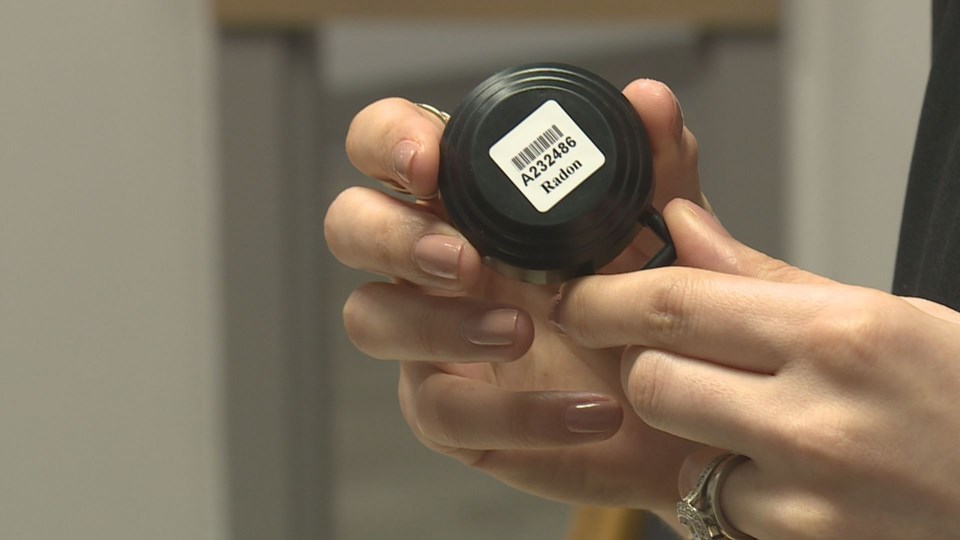SUNDRE — An odourless and naturally occurring gas that seeps up from decaying radioactive material underground is, according to the findings of a recent report, accumulating in many homes and buildings in and around town beyond Health Canada’s safety guidelines.
The results indicate that a little more than half of the houses tested had levels exceeding Health Canada’s maximum recommended limit of 200 Bq/m3. A becquerel (Bq) is a scientific unit used to measure the emission of radiation per second.
Although harmless outdoors, where the gas quickly dilutes to safe levels, radon can under the right circumstances build up to potentially dangerous concentrations in buildings, and is said to be a leading cause of lung cancer among non-smokers and the second highest cause of lung cancer among smokers.
Research also indicates children’s lungs are more susceptible than are adults to damage caused by long-term exposure of higher concentrations.
The report was released in late May by Take Action on Radon following the participation of 122 Sundre and surrounding area homeowners during the winter of 2020 in a national initiative called the 100 Radon Test Kit Challenge.
“One in two homes tested (53 per cent) had radon levels above the Canadian guideline,” reads a portion of a press release summarizing the findings.
A further 29 per cent tested between 100-200 Bq/m3, placing them just within Health Canada’s guidelines. However, those homeowners are encouraged to consider retesting within the following five years.
Only 18 per cent of the homes tested recorded levels under 100 Bq/m3.
The program involved voluntary participation and was in part facilitated through the Sundre Municipal Library, which previously hosted a presentation and coordinated with Take Action on Radon to help locally deliver the initiative by making available free tests.
“The Sundre Library was thrilled to participate in this project and happy to be able to make radon testing so easily accessible to community residents,” said Karen Tubb, manager.
Aside from signing up for the program and filling out both a pre- and post-test period survey online, participants simply had to place the test — a plastic device that resembles a small puck — for several months in a room where the home’s residents spend most of their time.
“We were pleased to see so many residents take on radon testing during the pandemic,” Pam Warkentin, Take Action on Radon project manager, said in a statement.
“In fact, as more people switched to working from home, we saw an even greater interest in learning about radon gas levels,” Warkentin said.
She was not particularly surprised by the results for Sundre and the surrounding area, where the gravel-laden ground is more porous and presents less of an obstacle for radon gas to slowly but surely seep through.
“It’s vitally important that all Albertans not only test their homes for radon, but also take action to lower their radon levels (if they exceed Health Canada guidelines) to protect from lung cancer,” said Warkentin, who is also the executive director of the Canadian Association of Radon Scientists and Technicians.
As radon is tasteless, colourless and odourless, the only way to determine how much radon gas might be accumulating is to test for it.
“Radon is a well-established human carcinogen, and testing and reducing radon levels is an important way to reduce lung cancer risk,” Dr. Anne-Marie Nicol, a researcher in the Faculty of Health Sciences at Simon Fraser University, was quoted as saying.
“Most people’s radon exposure comes from the time they spend at home, so more time at home leads to greater radon exposure overall,” Nicol said.
Since 2014, the Alberta Building Code has required the installation of a pipe through the basement floor of new houses. However, that only establishes a connection to facilitate the future installation of a radon mitigation system if later determined necessary.
The most suitable time to test is for a duration of about three months during the heating season.
Once installed — a job that can generally be completed by a certified professional within about a day — radon mitigation systems can reduce levels of the radioactive gas by an average of more than 90 per cent.
Even though the number of people who smoke is decreasing across Canada, lung cancer nevertheless remains a major problem in the country.
“On average, 58 Canadians will die from lung cancer every day, making it the leading cause of cancer death in Canada,” says Tricia Lewchuk, senior specialist with Tobacco Cessation, Canadian Cancer Society.
“It’s important that Canadians know they can control their risk from radon by testing their homes and reducing their exposure,” said Lewchuk.
Joy Willihnganz, Sundre library programmer, said the municipal council was also provided with correspondence recapping the initiative's results.
Anyone who missed the opportunity to participate can still test their homes. While different options are available for retail purchase, the library also has three digital radon detection devices available for loan.
Although less precise than the plastic pucks, they still present a good starting point to determine whether further testing might be advisable.
Alternatively, visit www.takeactiononradon.ca/test for more information as well as to order a test kit, while www.c-nrpp.ca/find-a-professional, Canada’s national radon certification program website, provides a searchable list of radon professionals.
Take Action on Radon is a national initiative funded by Health Canada that endeavours to bring together radon stakeholders and raise awareness throughout the country.
The initiative is led by the Canadian Association of Radon Scientists and Technologists, CAREX (CARcinogen EXposure) Canada, and the Canadian Cancer Society.



